
- •Abstract
- •Foreword
- •Executive summary
- •The drive for flexibility
- •Driven by portfolio players, LNG contracting activity rebounded to its highest level in five years…
- •… underpinned by longer, larger and more flexible contracts
- •Innovation in LNG contracting to enhance regional security of supply…
- •…means traditional buyers could become a larger source of additional flexibility for the Asian LNG market
- •The transformation of the broader energy system in north-western Europe…
- •…calls for the further enhancement of downstream gas flexibility
- •Findings and recommendations
- •Key findings
- •Update on LNG market flexibility metrics
- •LNG supply security in Asia: An opportunity for traditional buyers
- •North-western Europe’s gas flex: Still fit for purpose?
- •Technical analysis
- •1. Update on LNG market flexibility metrics
- •Introduction
- •Update on LNG contract trends
- •Liquefaction activity: New wave of investment gaining momentum
- •Export source and import destination: Flexible gas gaining ground
- •Longer and larger contracts do not mean less flexibility
- •Portfolio players and flexibility
- •Analysis of contract flexibility
- •Pricing trends
- •References
- •2. LNG supply security in Asia: An opportunity for traditional buyers?
- •Introduction
- •LNG flexibility in Asia
- •Flexibility in long-term contracts
- •Options in LNG contracts
- •Valuation of options
- •Flexibility in Japanese LNG contracting
- •Innovation in contracting
- •Expansion of LNG network
- •Creating joint ventures
- •Expanding LNG outlets
- •Proximity and security of supply
- •References
- •3. North-western Europe’s gas flex: Still fit for purpose?
- •Introduction
- •Gas flexibility toolkit
- •North-western Europe’s gas demand: Seasonality and volatility
- •Current state of flexibility tools
- •Upstream deliverability
- •Import capacity
- •Midstream interconnectivity
- •Storage capacity
- •A transforming energy system
- •References
- •General annex
- •Abbreviations and acronyms
- •Acknowledgements
- •Table of contents
- •List of figures
- •List of boxes
- •List of tables

Global Gas Security Review 2019 |
Findings and recommendations |
Findings and recommendations
Key findings
•Global gas markets continued to consolidate and evolve towards greater flexibility, driven by the increasing role of portfolio players, transforming business models, contracting trends and growing downstream flexibility requirements.
•LNG contracting activity rebounded to reach its highest level in five years in 2018, mostly resulting from newly sanctioned liquefaction projects. The contracting actions of market participants, especially portfolio players, have ensured that most contracts concluded in 2018 are destination-flexible.
•Contract flexibility is evolving to further strengthen security of supply in Asia. Long-term contracts involving traditional buyers can provide more operational flexibility than is generally recognised. Volume options, including diversions, open up the potential for increased co-operation via intra-regional trade between LNG buyers.
•In north-western Europe, rapidly declining domestic production and increasing import requirements, coupled with growing volatility in gas demand, signify an emerging need to further enhance the system flexibility of the region’s downstream gas infrastructure.
Update on LNG market flexibility metrics
Liquefied natural gas (LNG) contracting activity rebounded to reach its highest level in five years in 2018, mostly resulting from newly sanctioned liquefaction projects. 2018 and 2019 to date have seen a step change in investment activity compared to recent years:
After two years of low activity, several new projects took final investment decision (FID) in 2018: Corpus Christi LNG train 3, LNG Canada, Greater Tortue FLNG 1 and Tango FLNG.
Investment momentum has continued into the current year. 2019 to date has already seen the most natural gas liquefaction capacity ever sanctioned in a single year.
PAGE | 7
IEA. All rights reserved.
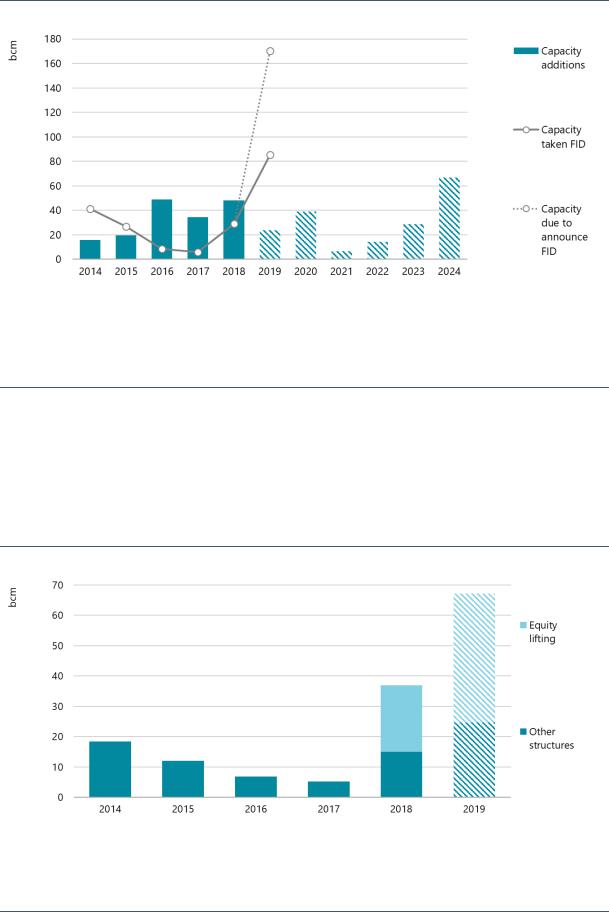
Global Gas Security Review 2019 |
Findings and recommendations |
Figure 1. Additions to global liquefaction capacity (2014–24) and FID volume (2014–19)
Note: Capacity additions are based on the announcements of developers and only include the capacity of projects that had taken FID by the time of writing this report.
Source: IEA analysis based on ICIS (2019), ICIS LNG Edge, https://lngedge.icis.com/ (subscription required).
A record-setting capacity of over 170 billion cubic metres (bcm) of natural gas liquefaction is due to take FID in 2019, far surpassing 2005’s previous record of 70 bcm.
Growing adoption of the equity offtake marketing structure has contributed to this recent boost in contracting activity and project sanctioning. In an equity offtake (or equity-lifting) model, partners have access to LNG market volumes according to their equity stake, reducing the need for longterm sale and purchase agreements (SPAs) to secure a project’s funding. Since this approach couples financing and offtake for prospective projects, developing under this model can accelerate the FID process.
Figure 2. FID-enabling contracts by signing year and structuring model (2014–19)
Note: 2019 data reflect contracts signed up to the time of writing.
Source: IEA analysis based on ICIS (2019), ICIS LNG Edge, https://lngedge.icis.com/ (subscription required).
After 2017, a shift to the equity-lifting model among FID-enabling deals appeared to accelerate FID timelines with a novel approach to financing.
PAGE | 8
IEA. All rights reserved.
Global Gas Security Review 2019 |
Findings and recommendations |
With more projects using an equity offtake model in 2018, long-term contracts (concluded contracts longer than ten years linked to projects that have already taken FID) grew by more than 55 bcm between 2017 and 2018. Large contracts (more than 4 bcm/year) and medium-sized contracts (between 2 bcm/y and 4 bcm/y) also increased (by almost 41 bcm), representing 56% of the total volumes signed in 2018.
Activity from market participants known as portfolio players has a major role in creating the flexibility to accommodate consumer preferences. Even though yearly contracted portfolio sales (exporting contracts) have been falling since 2015, they still accounted for 33% of concluded contracts linked to FID projects. Because the total volumes from this contracting activity outpace the volumes from expiring contracts, the market volumes portfolio players are obligated to supply increase at a steady pace in the medium term. This market share of total export contracts held by portfolio players is set to reach an all-time high by 2024 (54% of total export volumes).
Portfolio player activity has also had implications for importing regions. In 2018 contracts without a specific destination represented the largest share of contracting activity: these made up almost 45% of all concluded contracts linked to FID projects. During 2019 so far, this share is 68%. Portfolio players are responsible for a large share of deals developed during 2018 and 2019 to date, chiefly to rebuild their portfolios. Signed under flexible destination terms, these contracts provide the main source of volumes needed to cover their position. 2018 also exhibited a shift in the strategy of trading companies, signing long-term and larger contracts instead of relying exclusively on shortterm and spot deals. Just as with exports, the import volume share for portfolio players is projected to continue growing, increasing from 42% in 2018 to 48% in 2024.
Overall market flexibility has continued to improve, driven in some cases by contract commitments in North America:
Among export contracts, North America is the main source of 2018’s newly signed commitments. Of all 2018 concluded contracts associated with FID projects, 42% originate in North America. This is mostly due to the development of new LNG projects in the United States and Canada.
Destination flexibility is increasingly common: the number of contracts concluded with destination flexibility in 2018 was higher than in previous years. Still, many legacy contracts have destination clauses, meaning destination-flexible contracts do not yet represent the majority of market volumes.
PAGE | 9
IEA. All rights reserved.
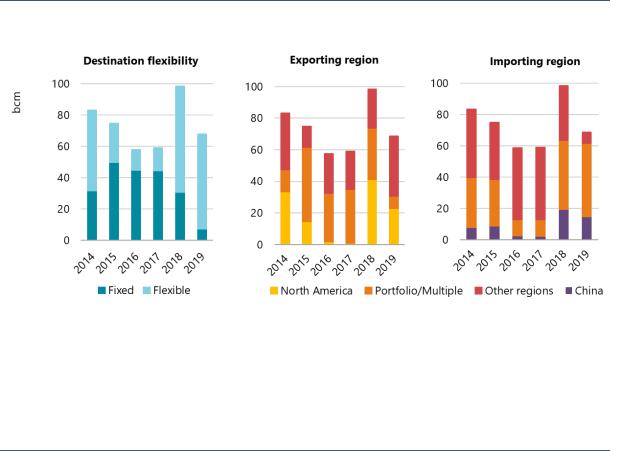
Global Gas Security Review 2019 |
Findings and recommendations |
Figure 3. Concluded LNG contracts by destination flexibility, exporting region and importing region (2014–19)
Notes: Data relate to contracts concluded and linked to projects that have already taken FID, as well as contracts concluded sourced from a portfolio. Data from 2019 include only the information available at the time of writing. In the exporting region chart, the Other regions category comprises Africa, Asia Pacific including People’s Republic of China (“China”), Eurasia, Europe, Middle East, and Central and South America. In the Importing region chart, the Other regions category comprises Africa, Asia Pacific excluding China, Eurasia, Europe, Middle East, and Central and South America.
Source: IEA analysis based on ICIS (2019), ICIS LNG Edge, https://lngedge.icis.com/ (subscription required).
A strong move to destination-flexible contracts is apparent as North America emerges as the key exporter and portfolio players as key buyers.
Some buyers with new and increasing demand for natural gas, particularly in Asia, still need to secure their supply and are actively signing new contracts. For example, the People’s Republic of China (hereafter, “China”) is rapidly expanding its imports, and among import contracts to single destinations China was the most popular destination in 2018 and so far during 2019. Of all FID project contract volumes, China’s contracts represented 20% in 2018 and 22% in 2019 to date. Driven by air quality policy measures and gas shortages seen in the winter of 2017/18 (IEA, 2018), Chinese buyers are seeking to reduce their exposure to supply risk and winter spot LNG price volatility. This willingness to contract reflects their interest in long-term supply protection.
Other contractual elements such as contract indexation have also seen further development. Gas contracts have increasingly been signed or renegotiated to include hub gas price indexation, reducing the historically predominant links to oil. North American export contracts constitute a large proportion of export contracts with gas-to-gas indexation that exist in the market today. During 2018 and 2019, diversification behaviour evolved further with the onset of new pricing structures based on the destination market and the use of the gas.
LNG supply security in Asia: An opportunity for traditional buyers
The structure of the Asian LNG market is undergoing a major shift. Demand from traditional LNG buyers, namely Japan and Korea, is likely to be flat or decline gradually depending on use in power generation. However, with or without a decline, these traditional buyers will still account for over 180 bcm/y of LNG purchases by 2024, or 60% of Asian LNG demand. Creating measures
PAGE | 10
IEA. All rights reserved.
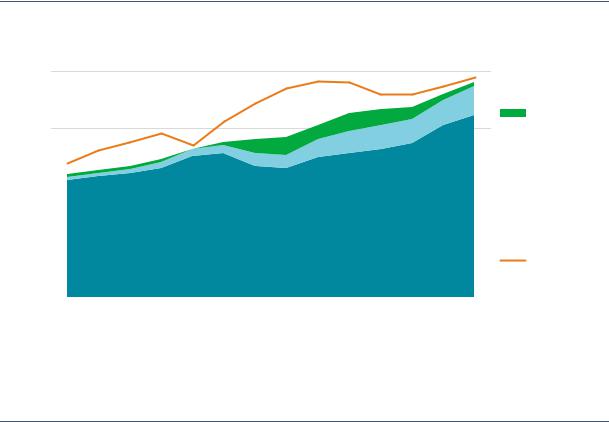
Global Gas Security Review 2019 |
Findings and recommendations |
to secure robust sources of LNG supply and meeting uncertainty of demand have been key objectives for these buyers.
Given the uncertainty in the demand level, buyers have been seeking greater flexibility in their supply contracts. The average duration of a contract in the traditional Asian LNG buyers’ portfolio is 20 years.
Figure 4. Structure of term contracts among traditional Asian LNG buyers and volume of LNG imports (2005–18)
bcm
200 |
|
|
Short-term |
150 |
(< 5 years) |
|
|
|
|
Medium-term |
|
|
|
|
|
|
|
|
|
|
100 |
|
|
|
(5-10 years) |
|
|
|
Long-term |
|
|
|
|
||
|
|
|
|
|
|
|
|
|
|
|
|
|
|
|
|
|
|
|
(> 10 years) |
50 |
|
|
|
Imported |
|
|
|
||
|
|
|
|
|
|
|
|
|
volume, all |
0 













 2005 2006 2007 2008 2009 2010 2011 2012 2013 2014 2015 2016 2017 2018
2005 2006 2007 2008 2009 2010 2011 2012 2013 2014 2015 2016 2017 2018
Note: Short-term contracts (< 5 years) do not include spot transactions.
Sources: IEA analysis based on data from ICIS (2019), ICIS LNG Edge, https://lngedge.icis.com/ (subscription required); imported volume data from GIIGNL (2019), GIIGNL Annual Report 2019, https://giignl.org/sites/default/files/PUBLIC_AREA/Publications/giignl_annual_report_2019-compressed.pdf.
Over 85% of LNG procurement by traditional Asian buyers is via long-term contracts to secure stable supply.
Options have become the tool of choice for increased flexibility. For example, cargoes can be increased in frequency to align with expected growth in demand (tranche option). A cargo can be sourced to meet a sudden increase in demand during a tight market (call option). At times of low demand, a cargo can be diverted to another market (diversion option) and be sold to such market without the risk of the cargo remaining unsold on the spot market (put option). This is a major improvement on the historically predominant demand adjustment mechanism, whereby a certain percentage of the annually contracted volume can be adjusted after the closure of the contract year, with the obligation carried forward.
Emerging Asian buyers are also seeking increased contractual flexibility. Most of the future growth in the Asia region is set to come from these non-traditional emerging buyers, namely Bangladesh, China, India and Pakistan. They are less dependent on LNG, with domestic gas production and pipeline imports available to them. However, ever-growing gas demand is quickly surpassing domestic production, meaning that more LNG is needed. This is creating a situation where LNG is required, but it has to compete on pricing with competition from domestically produced or pipeline imported natural gas.
PAGE | 11
IEA. All rights reserved.
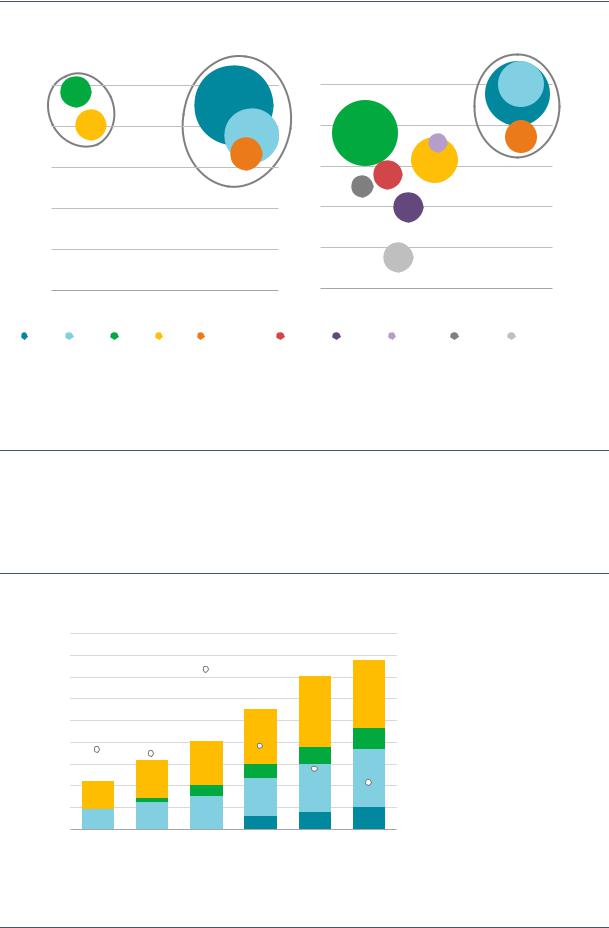
Global Gas Security Review 2019 |
Findings and recommendations |
Figure 5. Evolution of Asian LNG buyer types (2010–24)
|
|
|
2010 |
|
|
|
|
|
2024 |
|
|
Share of LT contracts in LNG supply |
|
|
|
|
|
|
|
|
|||
100% |
|
|
|
|
|
100% |
|
|
|
|
|
80% |
|
|
|
|
|
80% |
|
|
|
|
|
60% |
|
|
|
|
|
60% |
|
|
|
|
|
40% |
|
|
|
|
|
40% |
|
|
|
|
|
20% |
|
|
|
|
|
20% |
|
|
|
|
|
0% |
|
|
|
|
|
0% |
|
|
|
|
|
0% |
20% |
40% |
60% |
80% |
100% |
0% |
20% |
40% |
60% |
80% |
100% |
-20% |
|
|
|
|
Share of LNG in gas supply |
|
|
|
|
||
Korea |
China |
India |
Chinese Taipei |
-20% |
Pakistan |
Singapore |
Malaysia |
Bangladesh |
|||
Japan |
Thailand |
||||||||||
Note: LT = long-term.
Sources: IEA analysis based on data from ICIS (2019), ICIS LNG Edge, https://lngedge.icis.com/ (subscription required); 2024 is based on LNG forecast import data from IEA (2019a), Market Report Series: Gas 2019, https://webstore.iea.org/market-report-series-gas-2019.
The growth of LNG demand among emerging buyers will be strongly affected by the pricing of the competing fuels.
Expansion of LNG import capability is an urgent requirement to meet unpredictable levels of demand growth. This is where comprehensive contract flexibility becomes essential. In 2018 emerging Asian LNG buyers were overcontracted compared to actual imported volumes by 180%. Flexibility in their contracts allowed these excess contracted volumes to be managed.
Figure 6.
bcm |
180 |
|
|
|
160 |
140
120
100
80
60
40
20
0
LNG import volumes and percentage covered by contracts, emerging Asian economies (2014–24)
200%
150%
100%
50%
0%
2014 |
2016 |
2018 |
2020e |
2022e |
2024e |
 Other emerging
Other emerging
Asia economies
 Pakistan
Pakistan
 India
India
 Bangladesh
Bangladesh
 Average volume covered by contracts
Average volume covered by contracts
IEA, 2019. All rights reserved.
Emerging LNG buyers have on average 80% of their demand secured by contracts. However, the unavailability of imports or affordability mismatches may cause sudden supply and demand imbalances.
PAGE | 12
IEA. All rights reserved.
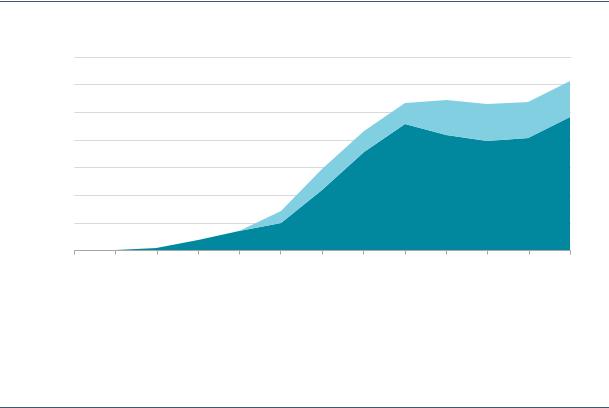
Global Gas Security Review 2019 |
Findings and recommendations |
The analysis shows that these emerging Asian LNG buyers are at an immature state in respect of long-term commitment to LNG over the coming years, reflecting their sensitivity to price and the ongoing development of their importing infrastructure.
One of the solutions could be in the form of traditional Asian LNG buyers, who can provide supplies of LNG using the flexibility in their contracts. It is estimated that 15 bcm/y of LNG contracted to traditional Asian LNG buyers can currently be considered destination-flexible. This destinationflexible volume would cover up to 15% of forecast LNG demand among emerging Asian LNG buyers.
Figure 7. LNG volumes contracted to traditional Asian LNG buyers with flexible destination (2012–24)
bcm/y
35
30
25
20
15
10
5
0 |
|
|
|
|
|
|
|
|
|
|
|
|
|
|
2012 |
2013 |
2014 |
2015 |
2016 |
2017 |
2018 |
2019 |
2020 |
2021 |
2022 |
2023 |
2024 |
||
|
|
|
|
|
|
Japan |
|
|
Others |
|
|
|
|
|
|
|
|
|
|
|
|
|
|
|
|
|
|
||
Sources: IEA analysis based on data from ICIS (2019), ICIS LNG Edge, www.icis.com/explore/services/analytics/lng-market-intelligence- solution/ (subscription required); 2024 is based on LNG forecast import data from IEA (2019a), Market Report Series: Gas 2019, https://webstore.iea.org/market-report-series-gas-2019.
LNG contracted to traditional Asian buyers with a flexible destination could cover up to 15% of LNG demand from emerging Asian LNG buyers, potentially providing them with extra flexibility.
Japanese buyers are expanding their LNG networks to implement contractual flexibility. Examples include the formation of joint ventures and jointly procuring contracts with other market participants. Also, the enlargement of receiving infrastructure is being observed in Japan, with additional loading capabilities at LNG terminals. This will enable these Japanese buyers to have an LNG outlet during fluctuations in demand, by reloading LNG onto another LNG vessel, into smallerscale ISO containers, or onto LNG bunker supply vessels. All such operations are enabled by the greater flexibilities that traditional Asian buyers have secured, thanks to ample additional supply and the emergence of portfolio players.
This additional layer of supply security in the Asian LNG market, over and above traditional suppliers and global portfolio players, also contributes to the operational robustness of the fastgrowing yet immature emerging buyers. The traditional Asian LNG buyers’ contractual flexibilities and implementation capabilities can further increase trading flows regionally and interregionally, serving new demand set to appear in other markets.
PAGE | 13
IEA. All rights reserved.
